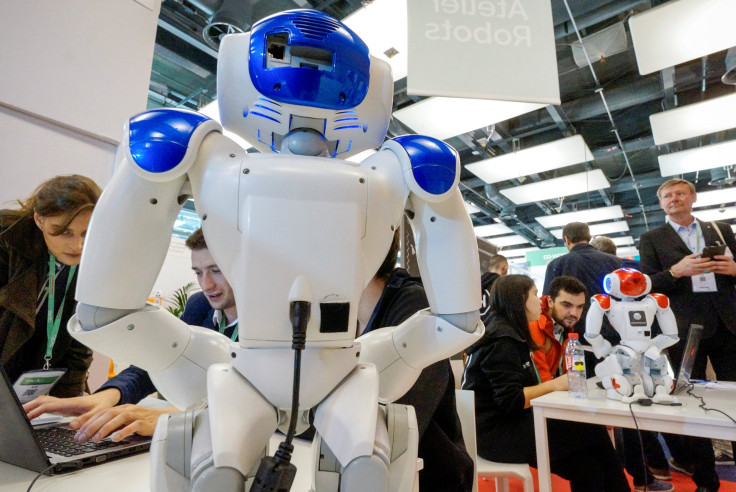Future Robots In The Workplace: 3 Ways Technology Is Helping Humans In The Labor Force

The Fourth Industrial Revolution has arrived. The first was the steam engine-driven Industrial Revolution; the second involved the innovations from Henry Ford’s assembly line. Third, microelectronics and computer power appeared on factory floors. Now, manufacturing businesses are beginning to integrate robotics, automation and other data-driven technologies into their workflows.
Robots have taken over difficult, dangerous and repetitive physical tasks, improving factory safety, worker comfort and product quality. The next phase of labor innovation will do the same thing for cognitive work, removing mentally stressful and repetitive tasks from people’s daily routines.
Human work will become more versatile and creative. Robots and people will work more closely together than ever before. People will use their unique abilities to innovate, collaborate and adapt to new situations. They will handle challenging tasks with knowledge-based reasoning. Machines enabled by the technologies that are now becoming commonplace – virtual assistants like Siri and Alexa, wearable sensors like FitBits and smart watches – will take care of tedious work details.
People will still be essential on the factory floors, even as robots become more common. Future operators will have technical support and be super-strong, super-informed, super-safe and constantly connected.
We call this new generation of tech-augmented human workers, both on factory floors and in offices, “Operator 4.0.” There are several types of enhancements available, which can be used individually or in combination to put humans at the heart of this technological revolution.
Super strong
One straightforward enhancement would let workers wear robotic exoskeletons to enhance their strength. A “super-strength operator” could let a human truly control the physical power of a large robot. In today’s warehouses and construction sites, workers risk injury and exhaustion by handling heavy objects themselves. Or they are forced to compromise, using a more powerful tool with less adaptability, like a forklift.
The benefits go well beyond the workplace. Of course, a worker in a powered robotic suit could easily handle extremely heavy objects without losing the flexibility of natural human movements. The worker would also be far less likely to suffer severe injuries from accidents or overwork. And at the end of a day, a super-strength worker could take off the exoskeleton and still have energy to play with the kids or spend time with friends.
Super informed
Fighter pilots use heads-up displays, which provide them with crucial information right on the cockpit windshield and directly in their line of sight. This is “augmented reality,” because it displays information within a live view of the world. It used to be very specialized and expensive technology. Now, Microsoft’s HoloLens makes it available for consumers.
An “augmented operator” can get directions or assistance without interrupting the task he or she is working on. Often, when new equipment or processes are developed, trainers need to travel long distances to factories, staying for weeks to teach workers what to do. Designers do the same, getting feedback for refinements and improvements. All that travel takes up a huge amount of time and is extremely expensive. With augmented reality available, it is often unnecessary.
A worker wearing a set of smart glasses can receive individualized, step-by-step instructions displayed right in front of his or her eyes, no matter where he or she is looking. With earbuds and a microphone, she or he could talk directly to trainers in real time.
Super safe
Many manufacturing environments are hazardous, involving heavy equipment, caustic chemicals and other dangers that can maim and kill human workers. A “healthy operator” may be equipped with wearable sensors tracking pulse rate, body temperature, chemical exposure or other factors that indicate risks of injury.
This type of system is already available: Truck drivers can wear the Maven Co-Pilot, a hands-free headset that detects fatigue symptoms, like head-bobbing movements. It can also ensure drivers check their rear-view mirrors regularly to stay aware of nearby traffic. It can even provide reminders to take scheduled breaks. This helps keep the truck’s driver safe and improves everyone else’s road safety.
And beyond…
Possibilities are limitless. An “analytical operator” would wear a monitor showing real-time data and analytics, such as information on chemicals in a sewage treatment plant or pollutants at an incinerator. A “collaborative operator” may be linked to collaborative robots, or co-bots, like the assembly assistant YuMi. A “smarter operator” could be equipped with an intelligent virtual personal assistant, like an advanced Siri or Alexa.
There does not have to be conflict between robots and humans, with machines taking people’s jobs and leaving them unemployed. Technology should be designed with collaboration in mind. That way, companies and workers alike will be able to capitalize on the respective strengths of both human and machine. What’s more, the inherent flexibility of “Operator 4.0” workers will also help to ensure workplaces of the future that can change and adapt. That means getting ever more efficient and safer, as new technologies emerge.
Thorsten Wuest, Assistant Professor & J. Wayne and Kathy Richards Faculty Fellow in Engineering, West Virginia University; David Romero, Professor of Advanced Manufacturing, Instituto Tecnológico y de Estudios Superiores de Monterrey, and Johan Stahre, Professor of Production Systems, Chalmers University of Technology
This article was originally published on The Conversation. Read the original article.

© Copyright IBTimes 2024. All rights reserved.





















